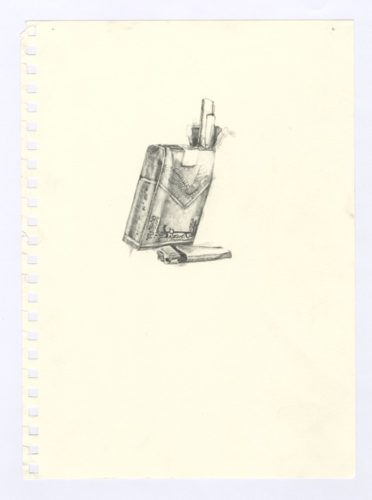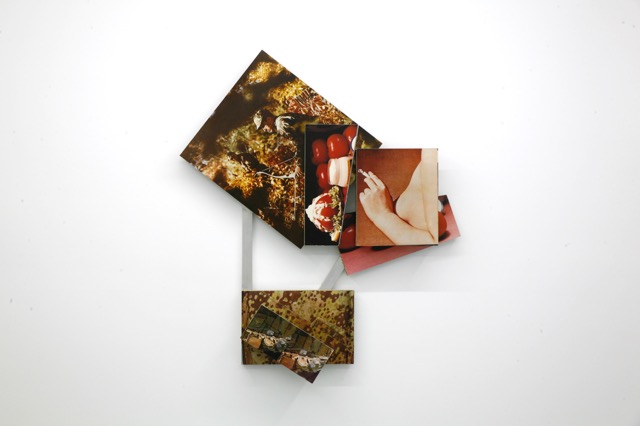
Installation view of Genesis Belanger’s Best Blue arrangement #1 (2016), Peter the Last Drag is for You (2016) and Bubble Gum arrangement #1 (2016) (Courtesy the artist and INVISIBLE-EXPORTS)
Frida Smoked
INVISIBLE-EXPORTS
89 Eldridge Street, New York, NY
On view now until June 19, 2016
Artists: Genesis Belanger, Anne Doran, Celeste Dupuy-Spencer, Ilse Getz, Irini Miga, and Amanda Nedham
What image is conjured by a woman smoker? Is she chain-smoking Betty Draper living in a Mad Men world defined by advertising and women’s magazines, or grungy and addled Courtney Love, tossing her lipstick-smeared cigarette butts at unsuspecting and adoring fans?
Whether exemplifying the height of ladylike femininity or illustrating the depths of a disheveled mess, there is no denying that throughout history, smoking has come to define numerous female stereotypes. Today with our juice-pressed, gluten-free and Pilates-toned body obsessions, cigarette smoking seems more transgressive than ever. With irrefutable medical knowledge about its dangers, and e-cigarettes appearing as a safer (and cheaper) alternative, smoking a cigarette, particularly in public, is now an antisocial statement. It’s a nicotine-stained finger in the eye of the health conscious legacy of former Mayor Michael Bloomberg’s anti-smoking initiatives, and other similar smoking bans around the world.
Invisible-Exports’ current exhibition Frida Smoked engages with both the lengthy historical legacy of women smokers, and the nihilistic, devil-may-care behavior of unrepentant ones. Frida Smoked is obviously not the exhibition to visit if you’re trying to quit smoking. Even if you aren’t a smoker, you’ll find yourself itching for a fix after attending. Better take some nicotine gum.
Bringing together a diverse lineup of six multidisciplinary women artists, Frida Smoked is yet another addition to the seemingly endless boom of all-women group shows. However, the exhibition defines itself apart from this glut of female-centric exhibitions by eschewing broad overreaching political actions. Instead, Frida Smoked focuses on refreshingly quirky individual acts of feminist rebellion that can be found in deconstructing cigarette smoking’s gender-enforcing eroticism and allure.
In their press release, Invisible-Exports offers an abridged history of women’s smoking. It begins in the 17th century, with cigarettes appearing solely in portraits of prostitutes and other “fallen” women. Eventually, women were pinpointed as a marketable demographic in the Mad Men era of mass-produced consumer products. Beyond its promotion to nervous midcentury housewives, the cigarette also developed a reputation since the 1920s as a marker for independent-minded women, as seen in the exhibition’s promotional image of Frida Kahlo hauling on a smoke.

Amanda Nedham, They burn everything here, 2016, Graphite on paper (Courtesy the artist and INVISIBLE-EXPORTS)
Despite this extended and rebellious history, Frida Smoked trades the over-the-top decadence that could define an exhibition about cigarettes for a surprisingly minimal and subdued tone. Part of this comes from Invisible-Exports’ subtle installation, which differs from the small gallery’s recently preferred salon hanging style. From Amanda Nedham’s adorable miniature animal cigarette sculptures to Celeste Dupuy-Spencer’s morning-after hangover portrait Mark the Floor and Irini Miga’s easily missed smashed cigarette butt, the art in Frida Smoked employs the formal qualities of a cigarette as much as its rich cultural symbolism.
For example, Genesis Belanger presents a geometric and abstract study of the cigarette as phallic object. With a series of sculptures — both wall-mounted and free-standing — alongside oil paintings, Belanger harnesses the cigarette’s immediately recognizable white and smoothly-rolled shape. Belanger’s limp cigarettes, like a flaccid penis, drape over hard-edged pink and blue steel structures in her sculptures, while two-dimensional versions float aimlessly through her paintings’ sparse picture planes. Compelling in their ambiguousness, Belanger’s works resemble Tom Wesselmann’s Pop cigarettes with their flatness and even Giorgio de Chirico’s desolate and surreal landscapes, taking on these predominantly masculine gestures and inverting them to construct her own aesthetic.
Of course, there can’t be an exhibition about smoking without an artwork made entirely from cigarette butts. Thankfully, Ilse Getz’s two cigarette collages fill this void. Getz’s Cigarette Collage VII and Musical Nightmare revel in the butts as an ephemeral record for the passing of time. Created almost two decades apart, the collages not only reveal that Getz switched brands, but also the sheer amount of cigarettes she smoked within a select period of time. While a precursor to Damien Hirst’s “Cigarette Cabinets”, Getz’s cigarette collages are rendered with a precise artistic hand and an eye for line and form that makes them much more organized than Hirst’s messy cigarette and ash-strewn works.
Like Getz’s cigarette collages, Amanda Nedham’s drawings also indicate the addiction of smoking and its relation to time, linking the daily need for a nicotine-fix with the urge to draw. With works like They burn everything here, which depicts an open pack of cigarettes next to a lighter, Nedham’s drawings sport frayed edges as if they were violently and suddenly ripped from a much-used private notebook. Through her paper’s worn imperfections, Nedham relates smoking with the enduring compulsion for artistic creation.

Anne Doran, Tomato Surprise, 1988, Color Photographs, aluminum (Courtesy the artist and INVISIBLE-EXPORTS)
Even though most of the art in Frida Smoked examines women’s smoking through more abstract means, one artwork that directly engages with the history of cigarettes and its targeted advertising toward women is Anne Doran’s 1988 wall-mounted aluminum sculpture Tomato Surprise. Titled as a nod to the mayonnaise and gelatin-covered vintage food ads that proliferated in the 1950s and 1960s, Tomato Surprise appropriates and combines apparently unrelated images such as a man bowhunting, a topless woman’s hand grasping a cigarette and — what I can only assume is — the ill-advised culinary creation “Tomato Surprise.” Placing these images side-by-side, Doran discovers unexpected connections between these disparate found materials, revealing each scene’s marketing origin.
Despite its wide range in imagery and mediums, Frida Smoked, taken as a whole, counters the monolithic and idealistic representation of the hypermasculine smoker, as well as artist. From the Marlboro Man to James Dean to Picasso, Pollock and countless other mythic “great white male” artists, smoking as a romantic and artistic gesture has largely belonged to the boy’s club. Proving that male artists are not the only ones allowed to reference, romanticize and aestheticize their vices, Frida Smoked rightfully asserts women’s potential to be equal rebels without a cause.


Comments on this entry are closed.